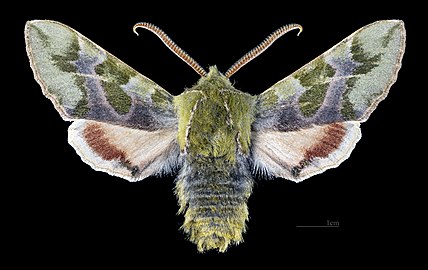Arctonotus lucidus
| Arctonotus lucidus | ||||||||||||
|---|---|---|---|---|---|---|---|---|---|---|---|---|

Arctonotus lucidus |
||||||||||||
| Systematics | ||||||||||||
|
||||||||||||
| Scientific name of the genus | ||||||||||||
| Arctonotus | ||||||||||||
| Boisduval , 1852 | ||||||||||||
| Scientific name of the species | ||||||||||||
| Arctonotus lucidus | ||||||||||||
| Boisduval , 1852 |
Arctonotus lucidus is the only butterfly species of the genus Arctonotus from the family of hawkers (Sphingidae). Due to the morphology of the genitals, the species is considered to be closely related to the genus Proserpinus , but is clearly differentiated from it. It is disputed whether Proserpinus terlooii should be assigned to the genus.
features
Characteristics of the moth
The brownish colored moths have a fore wing length of 18 to 23 millimeters. Their small size, the compact build, the greenish-gray fore wings and the pink-colored hind wings clearly distinguish the species from the other swarmers. The color of the fore wings varies from a fairly strong green to gray-green. The populations are colored differently depending on their area of distribution. For example, butterflies from Oregon and Washington are darker than those from California.
Characteristics of the caterpillars
Adult caterpillars have extensive dark markings that camouflage them well at the base of their food plants during the feeding breaks. They have a white to cream-colored or pale green basic color. The extent of the drawing, which can already appear in the third caterpillar stage, is quite variable. The anal horn becomes smaller with increasing development until it is finally only formed as a smooth, black elevation in the adult caterpillars.
Characteristics of the dolls
The doll has a smooth surface and is solid walnut brown. The trunk sheath is completely fused. The cremaster is quite narrow and ends in a double point.
Occurrence
The species is native to the western United States, much of California, eastern Oregon and Washington, and western Idaho. Presumably it also occurs in southern British Columbia. In particular, gorges with mixed chaparral and grassland with oak forests are populated in low elevations. You can find them at altitudes of 60 to 1070 meters.
Way of life
The adults fly in one generation in winter, which is why the animals are rarely caught and are therefore rare in collections. Due to the strong north-south spread of the species and the different altitudes that are populated, the flight times vary greatly. In southern California, the species flies from mid-January to early February, most of the more northern finds date from late February to early March. The males are often attracted by artificial light sources, while females are rarely attracted. Contrary to the opinion of Hodges (1971), the adults with their very short proboscis can probably not take in nectar and are inactive during the day.
The animals hatch in the late afternoon and take around two hours to unfold and dry their wings. Shortly thereafter, the females are ready to mate and attract attention. Mating takes place at sunset and lasts three to six hours. If a female does not find a partner by around 8:00 p.m., she stops luring and does not continue to do so until sunset the next day. Since they cannot ingest any food, this is likely to save their energy. The females carry a large number of eggs compared to all other North American hawks, an average of 389.
Food plants of the caterpillars
The caterpillars have been found on the fairy fan clarkie ( Clarkia breweri ) and Clarkia modesta from the evening primrose family (Onagraceae). Another migratory caterpillar find near Clarkia purpurea , Camissonia bistorta, and Camissonia strigulosa suggests that other evening primrose plants are also being eaten.
development
The females lay their eggs individually or in pairs during breeding. These are small, spherical, and pale green. Shortly after filing, they turn yellow. How the eggs are laid in nature and why the females form so many eggs is still unknown. The caterpillars hatch after about three weeks in breeding, in nature this can take longer due to the sometimes low temperatures of the habitats. The caterpillars are solitary and live on the underside of the leaves of their food plants. Pupation takes place in a stable chamber under parts of plants and the like just below the surface of the earth. The mortality rate of the animals at this stage is high.
supporting documents
Individual evidence
- ↑ a b c d e f g h i James P. Tuttle: The Hawkmoths of North America, A Natural History Study of the Sphingidae of the United States and Canada. The Wedge Entomological Research Foundation, Washington, DC 2007, ISBN 978-0-9796633-0-7 .
literature
- James P. Tuttle: The Hawkmoths of North America, A Natural History Study of the Sphingidae of the United States and Canada. The Wedge Entomological Research Foundation, Washington, DC 2007, ISBN 978-0-9796633-0-7 .

